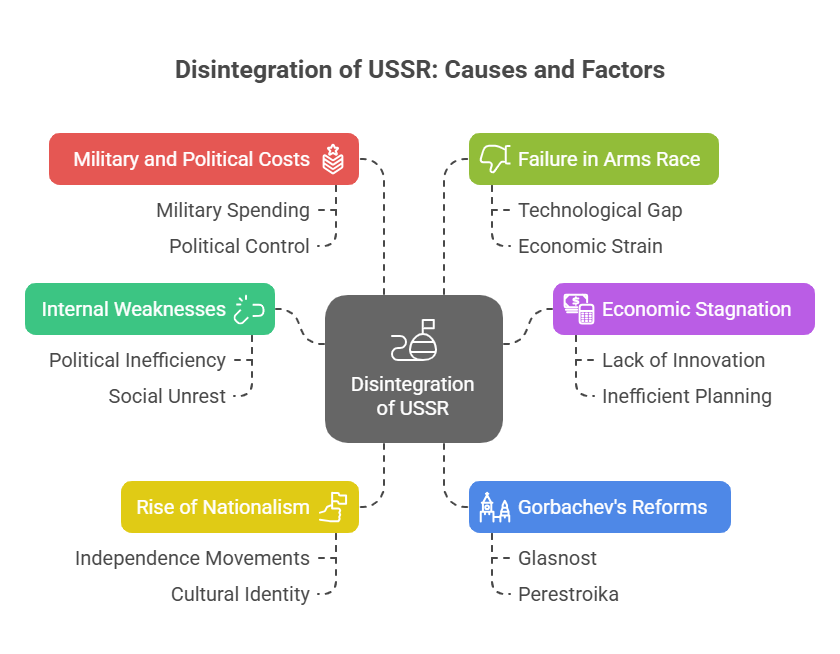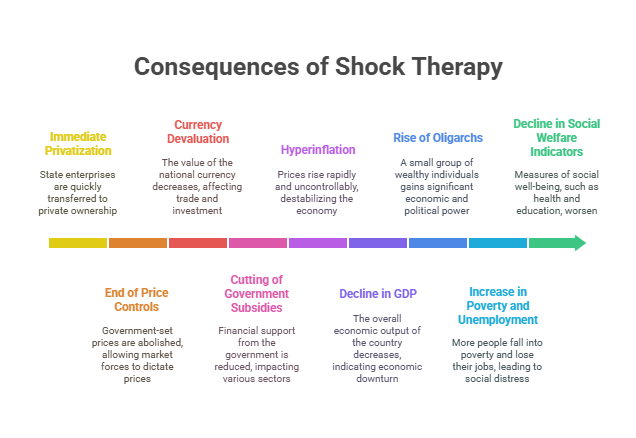Chapter 1 End of Bipolarity
Introduction
The chapter discusses the collapse of the Soviet Union and the end of the Cold War bipolar world order, leading to the emergence of a unipolar world dominated by the United States.
1. The Soviet System
Features of Soviet System:
- Established after 1917 Russian Revolution
- Based on socialist principles with state-controlled economy
- Single-party system (Communist Party of Soviet Union)
- Minimal private ownership
- Welfare state with subsidized basic necessities
Achievements:
- Eliminated inequality
- Improved education and healthcare
- Superpower status with military and economic might
- Developed nuclear technology
Weaknesses:
- Bureaucratic and authoritarian system
- Lack of democracy and freedom
- Stagnant economy in later years
- High expenditure on military
- Dominance of Russia over other republics
2. Gorbachev's Reforms
Mikhail Gorbachev introduced reforms to revive the Soviet system:
- Perestroika (Restructuring): Economic reforms to introduce market elements
- Glasnost (Openness): Greater freedom of expression
These reforms unintentionally accelerated the collapse of the USSR.
3. Disintegration of USSR
Reasons:
- Internal weaknesses of Soviet system
- Economic stagnation
- Rise of nationalism in Soviet republics
- Gorbachev's reforms backfiring
- Military and political costs of maintaining empire
- Failure to match US in arms race

Why USSR got Disintegrated?
Timeline of Disintegration:
| 1985 |
Gorbachev becomes General Secretary |
| 1989 |
Fall of Berlin Wall, Revolutions in Eastern Europe |
| 1990 |
Baltic republics declare independence |
| December 1991 |
Russia, Ukraine, Belarus declare USSR dissolved |
| December 25, 1991 |
Gorbachev resigns, USSR officially ceases to exist |
4. Consequences of Disintegration
- End of Cold War and bipolar world order
- Emergence of US as sole superpower (unipolar world)
- Democratization of former Soviet republics
- End of ideological conflict between capitalism and socialism
- Emergence of new independent states
- Changes in balance of power in international organizations
- Rise of new issues like terrorism replacing Cold War concerns
- Beginning of globalization process
5. Shock Therapy
Radical transition from socialism to capitalism:
A painful process of transition from an authoritarian socialist
system to a democratic capitalist system in Russia, Central Asia and east Europe that was influenced by
the World Bank and the IMF came to be known as ‘shock therapy’
Consequences of Shock Therapy:
- Immediate privatization of state enterprises
- End of price controls
- Currency devaluation
- Cutting of government subsidies
- Hyperinflation
- Decline in GDP
- Rise of oligarchs
- Increase in poverty and unemployment
- Decline in social welfare indicators

Consequences of Shock therapy
6. India and Post-Soviet Russia
- India maintained good relations with Russia after USSR collapse
- Continued defense cooperation
- Energy partnership (oil and gas)
- Strategic partnership agreement signed in 2000
- Russia supports India's position on Kashmir
- India supports Russia's position on Chechnya
Key Terms
- Bipolarity: World order with two superpowers (US and USSR during Cold War)
- Unipolarity: World order with single superpower (US after Cold War)
- CIS: Commonwealth of Independent States formed by former Soviet republics
- Oligarchs: Wealthy business leaders who gained control of former state enterprises
- Warsaw Pact: Military alliance of communist states (dissolved in 1991)
7. Important Questions
- What were the factors responsible for the disintegration of USSR?
- Explain the consequences of disintegration of Soviet Union.
- What was Shock Therapy? What were its consequences?
- How did the end of bipolarity affect India's foreign policy?
- Compare and contrast the Soviet system with the capitalist system.
- What was soviet system? Mention its achievements and weaknesses.
